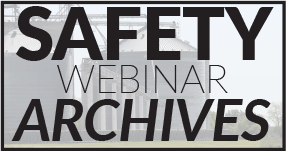| View HTML Version of Newsletter |
||||||||
 |
||||||||
 |
||||||||
Reducing Grain Handling Facility Hazards |
|
Published Every Monday by Grain Journal Editor Kendall Trump Unsubscribe |
||||||
| What can be done to reduce the hazards in grain handling facilities | ||||||||
|
On August 4, 2010 and again on February 1, 2011, OSHA issued warning letters to the grain handling industry following a series of incidents including the recent suffocation of 2 teenagers in Illinois grain elevator. In response to the rising number of workers entrapped and killed in grain storage facilities, OSHA has also issued a new fact sheet, Worker Entry Into Grain Storage Bins in August 2010 for workers and employers emphasizing the hazards of grain storage bin entry and the safe procedures that all employers must follow. Additionally, OSHA issued a safety and health information bulletin (SHIB) entitled, Combustible Dust in Industry: Preventing and Mitigating the Effects of Fire and Explosions, and a Hazard Alert: Combustible Dust Explosions fact sheet. These standards reduce the risk to workers by requiring that employers follow established, common sense safety practices when working in grain handling facilities. Standing on moving grain is deadly; the grain can act like "quicksand" and bury a worker in seconds. Moving grain out of a bin while a worker is in the bin creates a suction that can pull the workers into the grain in seconds. 2. Prohibit walking down grain and similar practices where an employee walks on grain to make it flow. 3. Provide all employees a body harness with a lifeline, or a boatswains chair, and ensure that it is secured prior to the employee entering the bin. 4. Provide an observer stationed outside the bin or silo being entered by an employee. Ensure the observer is equipped to provide assistance and that their only task is to continuously track the employee in the bin. Prohibit workers from entry into bins or silos underneath a bridging condition, or where a build-up of grain products on the sides could fall and bury them. 5. Train all workers for the specific hazardous work operations they are to perform when entering and working inside of grain bins. 6. Test the air within a bin or silo prior to entry for the presence of combustible and toxic gases, and to determine if there is sufficient oxygen. 7. If detected by testing, vent hazardous atmospheres to ensure that combustible and toxic gas levels are reduced to non hazardous levels, and that sufficient oxygen levels are maintained. 8. Ensure a permit is issued for each instance a worker enters a bin or silo, certifying that the precautions listed above have been implemented. To prevent dust explosions and fires, employers must (among other things): 2. Identify "priority" housekeeping areas in grain elevators. The "priority" housekeeping areas include floor areas within 35 feet of inside bucket elevators, floors of enclosed areas containing grinding equipment and floors of enclosed areas containing grain dryers located inside the facility. Dust accumulations in these priority housekeeping areas shall not exceed 1/8th inch. Employers should make every effort to minimize dust accumulations on exposed surfaces since dust is the fuel for a fire or explosion, and it is recognized that a 1/8 inch dust accumulation is more than enough to fuel such occurrences. 3. Inside bucket elevators can undergo primary explosions. OSHA's grain handling standard requires that belts for these bucket elevators purchased after March 30, 1988 are conductive and have a surface electrical resistance not exceeding 300 megohms. Bucket elevators must have an opening to the head pulley section and boot section to allow for inspection, maintenance, and cleaning. Bearings must be mounted externally to the leg casing or the employer must provide vibration, temperature, or other monitoring of the conditions of the bearings if the bearings are mounted inside or partially inside the leg casing. These bucket elevators must be equipped with a motion detection device which will shut-down the elevator when the belt speed is reduced by no more than 20% of the normal operating speed. 4. Implement a preventative maintenance program with regularly scheduled inspections for mechanical and safety control equipment, which may include heat producing equipment such as motors, bearings, belts etc. Preventive maintenance is critical to controlling ignition sources. The use of vibration detection methods, heat sensitive tape or other heat detection methods can help in the implementation of the program. 5. Minimize ignition sources through controlling hot work (electric or gas welding, cutting, brazing or similar flame producing operations). 6. Install wiring and electrical equipment suitable for hazardous locations. 7. Design and properly locate dust collection systems to minimize explosion hazards. All filter collectors installed after March 1988 shall be located outside the facility or located in an area inside the facility protected by an explosion suppression system or located in an area that is separated from other areas by construction having at least a one hour fire resistance rating and which is located next to an exterior wall vented to the outside. 8. Install an effective means of removing ferrous material from grain streams so that such material does not enter equipment such as hammer mills, grinders and pulverizers. For more information, see OSHA standard (29 CFR 1910.272). Source: OSHA Website - https://www.osha.gov/SLTC/grainhandling/
|
 |
|||||||
 |
||||||||
Current Issue: |
||||||||
USEFUL INFO Product/Service Directory Equipment Catalog Digital Edition Archives 2018-19 Grain/Feed/Milling Convention Calendar |
||||||||
 |
||||||||
| Grain Journal is a bi-monthly magazine for the grain and feed industries published in Decatur, IL - 800-728-7511 | website: www.grainnet.com Click here to forward this newsletter to a friend. |
||||||||